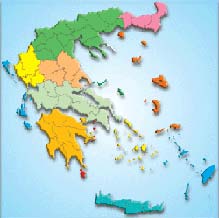
Please click on the map,
the region you want to visit |
|
|
|
|
| |
|
 |
Lefokastro, fountains of the area |
|
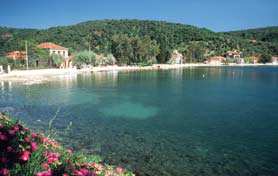 |
| Lefokastro |
|
|
|
This settlement has deep roots in history as traces have been found mainly from the Early Christian times such as a medieval castle. The first component of the name, according to several scenarios, comes either from the verb lick (the settlement "is licked by the sea" or from the word Lefko (white) (the corresponding colour of the castle), or from the name of one of the first settlers (Lefas or Lefes). The monuments that stand out in the area, are the remains of nine Byzantine churches, an arched bridge of 1891 (a donation by Georgatzis C.) and a fountain of 1777, with two "handfuls" and two signs, a Turkish one with the name of the donor Ahmet Aga and a Greek one, with a carved double-headed eagle.
Today, Lefokastro retains traces of its old character and is recommended to those who want a mild tourism activity. |
|
Fountains
We find fountains in a large number in villages as well in rural areas. It is an essential element in the squares, in the courtyards of churches, at the network of footpaths and across the paved network of the settlements.
Our forefathers gave a great importance to these fountains and to their buildings. This importance is shown by the number of folk songs, legends and events that were related to them.
According to their basic characteristics, the fountains are classified into two different types:
- Simple Fountains
The Simple Fountains are fixed on a wall and have a single or double "handful" from which the water runs. Right and left of the indentation there are other smaller that are used for placing small items.
On the bottom there is always the "pit", which is carved in stone or built and is used for watering the animals.
- Roofed Fountains
The roofed Fountains have rectangular shape, one side is built in which there are "handfuls" of water, while in the opposite there are stone pillars or wooden poles that supporting the roof, which is always covered with slate plates.
- Vaulted roofed Fountains
Another, but rare kind, are the vaulted fountains. We find them in Promiri. There are perimeter benches that complete the structure and serve for the rest of people.
The more complex have the form of a chapel. They are based on Corinthian columns with high bases, with pilasters and pediment with various shapes.

DECORATION
The craftsman who manufactured the fountains, decorated them with a multitude of images, made of stone, which were inspired by the plant and the animal kingdom,
the myths and the history, and also it is not absent the religious tradition with the various Christian symbols like the cross, all of which together formed a unique work of the folk architecture and the sculpture (pots, flowers, animals, double-headed eagles, anthropomorphic masks, etc.).
• Fountain of St. Nicholas in Pau
It is natural, the water stems from three springs. The town and the Monastery of St. Nicholas built around this fountain. The tradition says that during the big droughts in the region of Argalasti, this fountain had kept enough water for the needs of the humans and the animals. It is also called Megali Vrisi (Great Fountain).
Above the fountain, is written:
"Community Paou of Argalasti
September 1951" |
|
|
• Fountain of Koueni
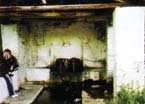 The fountain of Koueni is too old and this is obvious from the ancient trees, which are surrounding it and from the settlements that were built in Argalasti during these centuries. The fountain of Koueni is too old and this is obvious from the ancient trees, which are surrounding it and from the settlements that were built in Argalasti during these centuries.
• Fountain of St. John
It is also built by a Turkish pasha. This fountain had kept water during all big droughts and had served the residents.
There is a story for the fountain of Saint John that the elders say. In the years of our grandfathers, those who had fields in the region took water to irrigate their fields and their trees with the so-called method "in turns". Others had their turn in hours, others in day and others in night.
Some cheaters in order to get water and at night, did an artifice. Around midnight, the cheaters brought two rams in front of the tap, and they had covered them with white sheets. The animals, scared as they were, began to kick. After a while, the locals that was their turn to take the water, reached there. As they saw in the dark something weird white to swing, they thought that were ghosts and they left the place.
• Fountain of Myriovrytis
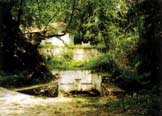 This beautiful fountain is located northwest of Argalasti, beneath the beautiful and picturesque church of Agios Konstantinos, near to Katsilochori and it is in the settlement of Myriovrytis. Many tourists visit it every year. This beautiful fountain is located northwest of Argalasti, beneath the beautiful and picturesque church of Agios Konstantinos, near to Katsilochori and it is in the settlement of Myriovrytis. Many tourists visit it every year.
According to tradition, a beautiful girl came out one morning and a ghost saw her and felt jealousy. So, it transformed her into a fountain.
• Fountain of Kamara
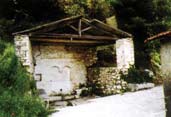 The fountain is located 1 km from Argalasti, near the chapel of Sts. Anargyri. The fountain is located 1 km from Argalasti, near the chapel of Sts. Anargyri.
The fountain, according to tradition, was built when one night someone went to collect his flock and suddenly saw there the Saints Anargyroi. For this reason, this fountain is considered as a sacred fountain.
Later, at a nearby place, the church of St. Anargyroi was built.
• Fountain of Katsilochori
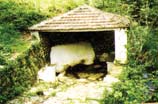 You will find this very beautiful fountain 1klm away from Argalasti, underneath the slaughterhouses. It is situated among big and ancient trees there for over 100 years. It was renovated in 1940. You will find this very beautiful fountain 1klm away from Argalasti, underneath the slaughterhouses. It is situated among big and ancient trees there for over 100 years. It was renovated in 1940.
It was built by a shepherd who when a warm night went there to refresh himself, the fairies took his speech. |
 |
Accommodation proposals, entertainment and shopping in Lefokastro |
|
|
|